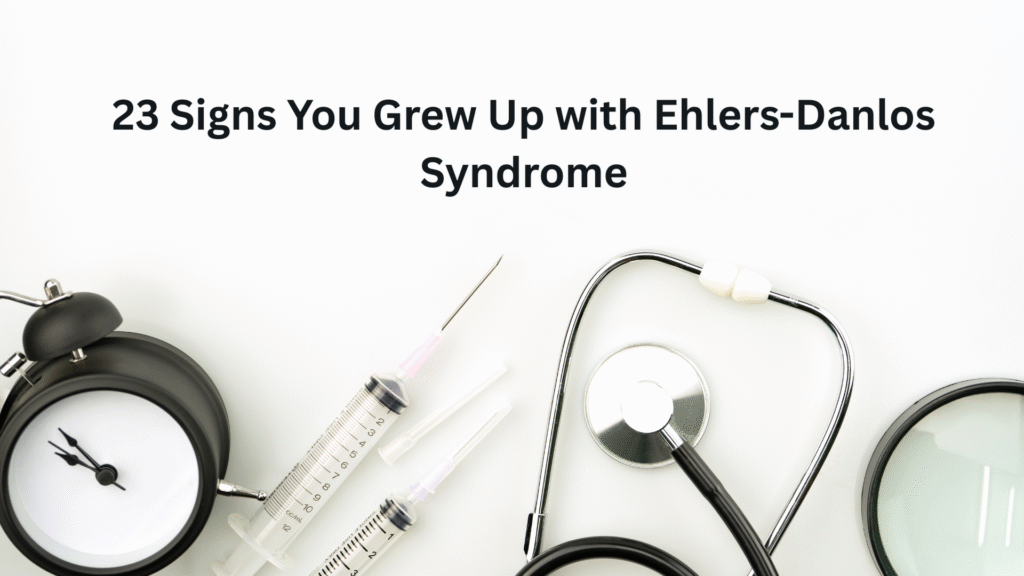If you ever wondered why your childhood felt different—marked by constant bruises, joint pain, or unexplained fatigue—you might recognize yourself in the experience of growing up with Ehlers-Danlos Syndrome (EDS). This rare connective tissue disorder is often misunderstood, misdiagnosed, or dismissed as “just being clumsy.” Yet for those who lived it from the beginning, the signs were always there. From hypermobile joints to fragile skin and a lifetime of “mystery symptoms,” growing up with EDS shapes nearly every part of life. This article explores 23 signs you grew up with Ehlers-Danlos Syndrome, combining medical insight with the lived realities of patients, so readers can better understand their bodies, histories, or loved ones.
What Is Ehlers-Danlos Syndrome?
Ehlers-Danlos Syndrome is not a single condition but a group of inherited disorders affecting connective tissue—the body’s “glue” that supports skin, joints, blood vessels, and organs. In EDS, the collagen doesn’t work properly. That means the structures that should be strong and elastic are instead fragile, loose, or overly flexible.
Growing up with EDS often means living with symptoms before having a name for them. Many children are misdiagnosed with anxiety, hypochondria, or dismissed as being too sensitive. Only later, sometimes decades later, does the puzzle begin to fit.
23 Signs You Grew Up with Ehlers-Danlos Syndrome
1. You Were Always the “Flexible Kid”
On the playground, classmates marveled when you could bend your thumb to your wrist or twist into odd shapes. Adults might have praised your “party tricks,” not realizing it was hypermobility—a hallmark of EDS.
2. Frequent Joint Dislocations and Subluxations
Your shoulder popped out during gym class. Your kneecap slipped when you ran. What others saw as freak accidents were part of daily life for you.
3. Endless Bruises with No Memory of Injury
EDS skin bruises easily because the blood vessels and connective tissues are fragile. Many remember being scolded for looking “careless.”
4. Chronic Pain Before You Even Understood the Word
While peers bounced back after games, you limped, ached, or needed to rest far longer. Pain became normal.
5. A Reputation for Being “Clumsy”
You fell more often, tripped on nothing, or had poor balance because your joints lacked stability.
6. Stretchy, Velvety Skin
Friends tugged at your skin, amazed at how far it stretched. Some even nicknamed you “elastic.”
7. Slow-Healing Wounds and Fragile Scars
Scrapes left paper-thin scars. Surgery wounds took longer to close. Teachers wondered why your knees always looked “patched up.”
8. Fatigue That Never Matched Your Age
No matter how much you slept, exhaustion followed. Growing up with EDS often meant being labeled “lazy” instead of ill.
9. Digestive Complaints No Doctor Could Explain
Stomachaches, nausea, constipation, reflux—many children with EDS lived with mysterious GI troubles.
10. Dizziness When Standing Up
Orthostatic intolerance, later recognized as POTS (postural orthostatic tachycardia syndrome), left you lightheaded every time you rose too fast.
11. Teachers Called You Distracted, But It Was Brain Fog
Fatigue, chronic pain, and poor blood flow often affect concentration, making school harder than outsiders realized.
12. Allergies and Sensitivities
From rashes to unexplained food intolerances,23 signs you grew up with ehlers-danlos syndrome your body reacted unpredictably to environments or diets.
13. Dental and Jaw Problems
TMJ disorders, crowded teeth, or fragile gums became part of your early dental visits.
14. You Couldn’t Keep Up in Sports
Running hurt your ankles, dancing strained your knees, and coaches thought you weren’t trying hard enough.
15. Heart Palpitations or Unusual Heart Murmurs
Cardiac involvement in EDS meant fainting spells or irregular beats—terrifying symptoms brushed off as “nerves.”
16. Scars That Looked Like Cigarette Paper
Thin, papery scars became a telltale physical marker you carried from childhood.
17. Needing Extra Time to Write in School
Hand pain and fatigue slowed you down, making exams feel like physical endurance tests.
18. Random Swelling and Inflammation
Knees ballooned after small activities. Fingers puffed after writing. Your body seemed to overreact constantly.
19. Being the “Fragile” Child in the Family
Siblings climbed trees. You stayed behind or paid with weeks of pain if you joined.
20. Doctors Who Dismissed You
Perhaps the most universal sign: countless appointments ending with, “It’s just growing pains,” or “You’ll grow out of it.”
21. Needing Adaptive Strategies Early
You learned tricks: gripping pens differently, bracing joints, or quietly hiding injuries to avoid attention.
22. Anxiety Born from Physical Uncertainty
Would your hip slip today? Would you faint in class? The unpredictability fed worry, long before diagnosis.
23. Feeling Relieved When You Finally Got Answers
Even if late, receiving a diagnosis of EDS brought validation: your childhood wasn’t “all in your head.”
Quotes from Real Experiences
- “I thought everyone’s knees bent backward. It wasn’t until high school that I realized mine weren’t supposed to.”
- “Doctors told me I was attention-seeking. Decades later, they admitted it was EDS all along.”
- “Growing up with EDS isn’t just about the pain—it’s about the confusion of never fitting the medical boxes.”
Table: Common Childhood Signs of EDS vs. Misinterpretations
| Childhood Experience | Common Mislabeling by Adults | Underlying Reality in EDS |
|---|---|---|
| Frequent bruising | Careless or accident-prone | Fragile blood vessels and skin |
| Slow wound healing | Poor hygiene or clumsiness | Collagen defects slow repair |
| Joint popping/dislocations | Exaggeration or dramatization | Instability from hypermobility |
| Fatigue and brain fog | Laziness or inattention | Energy drain from chronic pain and POTS |
| Digestive pain | Picky eating, stress, or “nerves” | GI involvement in connective tissue |
The Emotional Landscape of Growing Up with EDS
EDS isn’t only physical. Childhood is shaped by how others perceive and respond to symptoms. Many grow up doubting themselves, feeling dismissed, or internalizing blame. The emotional scars often last longer than the physical ones.
One patient described: “The hardest part wasn’t the pain—it was not being believed. Every doctor’s shrug was another weight on my shoulders.”
What Readers Should Take Away
Recognizing these 23 signs doesn’t mean self-diagnosing. Instead, they highlight patterns worth discussing with a knowledgeable physician. Awareness is the first step in shortening the diagnostic journey, which historically averages more than a decade.
Growing up with EDS means more than quirky joints. It’s a childhood lived in negotiation—with bodies, with pain, with misunderstanding. Yet awareness empowers the next generation to receive support earlier.
FAQs
1. Can someone have EDS without obvious hypermobility?
Yes. While hypermobility is common, some EDS subtypes present more with skin fragility, vascular symptoms, or chronic pain.
2. Is EDS always genetic?
EDS is typically genetic, caused by mutations in collagen-related genes. Family history often reveals undiagnosed relatives.
3. What should I do if I recognize these signs in myself or my child?
Schedule an evaluation with a geneticist or rheumatologist. Keep a detailed symptom log to support the appointment.
4. Can EDS symptoms improve with age?
Some symptoms stabilize, but many worsen over time. Early management—like physiotherapy, pacing, and bracing—improves quality of life.
5. What lifestyle adjustments help children with EDS?
Low-impact exercise, hydration, joint protection, and supportive schooling accommodations can reduce daily strain.







